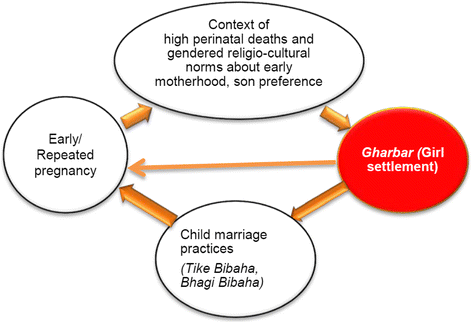A qualitative study about the gendered experiences of motherhood and perinatal mortality in mountain villages of Nepal: implications for improving perinatal survival
- PMID: 29764385
- PMCID: PMC5952814
- DOI: 10.1186/s12884-018-1776-3
A qualitative study about the gendered experiences of motherhood and perinatal mortality in mountain villages of Nepal: implications for improving perinatal survival
Abstract
Background: We aim to examine the gendered contexts of poor perinatal survival in the remote mountain villages of Nepal. The study setting comprised two remote mountain villages from a mid-western mountain district of Nepal that ranks lowest on the Human Development Index (0.304), and is reported as having the lowest child survival rates in the country.
Methods: The findings are taken from a larger study of perinatal survival in remote mountain villages of Nepal, conducted through a qualitative methodological approach within a framework of social constructionist and critical theoretical perspectives. Data were collected through in-depth interviews with 42 women and their families, plus a range of healthcare providers (nurses/auxiliary nurses, female health volunteers, support staff, Auxiliary Health Worker and a traditional healer) and other stakeholders from February to June, 2015. Data were analysed with a comprehensive coding process utilising the thematic analysis technique.
Results: The social construction of gender is one of the key factors influencing poor perinatal survival in the villages in this study. The key emerging themes from the qualitative data are: (1) Gendered social construct and vulnerability for poor perinatal survival: child marriages, son preference and repeated child bearing; (2) Pregnancy and childbirth in intra-familial dynamics of relationships and power; and (3) Perception of birth as a polluted event: birth in Gotha (cowshed) and giving birth alone.
Conclusions: Motherhood among women of a low social position is central to women and their babies experiencing vulnerabilities related to perinatal survival in the mountain villages. Gendered constructions along the continuum from pre-pregnancy to postnatal (girl settlement, a daughter-in-law, ritual pollution about mother and child) create challenges to ensuring perinatal survival in these villages. It is imperative that policies and programmes consider such a context to develop effective working strategies for sustained reduction of future perinatal deaths.
Keywords: Childbirth; Gender; Motherhood; Mountain; Nepal; Perinatal survival.
Conflict of interest statement
Ethics approval and consent to participate
This research was approved by the research ethics committees of Nepal Health Research Council and Flinders University, Adelaide, Australia. The District Health Office in Nepal allowed access to mortality data and related documents, and permitted the first author to enter the villages for this study. Written informed consent was sought from all participants before the start of each interview.
Competing interests
The authors declare that they have no competing interests.
Publisher’s Note
Springer Nature remains neutral with regard to jurisdictional claims in published maps and institutional affiliations.
Figures
Similar articles
-
Health system barriers influencing perinatal survival in mountain villages of Nepal: implications for future policies and practices.J Health Popul Nutr. 2018 Jul 5;37(1):16. doi: 10.1186/s41043-018-0148-y. J Health Popul Nutr. 2018. PMID: 29976245 Free PMC article.
-
Religio-cultural factors contributing to perinatal mortality and morbidity in mountain villages of Nepal: Implications for future healthcare provision.PLoS One. 2018 Mar 15;13(3):e0194328. doi: 10.1371/journal.pone.0194328. eCollection 2018. PLoS One. 2018. PMID: 29544226 Free PMC article.
-
Childbirth traditions and cultural perceptions of safety in Nepal: critical spaces to ensure the survival of mothers and newborns in remote mountain villages.Midwifery. 2013 Oct;29(10):1173-81. doi: 10.1016/j.midw.2013.06.002. Epub 2013 Jul 8. Midwifery. 2013. PMID: 23845450
-
Dirty and 40 days in the wilderness: Eliciting childbirth and postnatal cultural practices and beliefs in Nepal.BMC Pregnancy Childbirth. 2016 Jul 5;16(1):147. doi: 10.1186/s12884-016-0938-4. BMC Pregnancy Childbirth. 2016. PMID: 27381177 Free PMC article. Review.
-
How natural is the supernatural? Synthesis of the qualitative literature from low and middle income countries on cultural practices and traditional beliefs influencing the perinatal period.Midwifery. 2016 Aug;39:87-97. doi: 10.1016/j.midw.2016.05.005. Epub 2016 May 10. Midwifery. 2016. PMID: 27321725 Review.
Cited by
-
Health system barriers influencing perinatal survival in mountain villages of Nepal: implications for future policies and practices.J Health Popul Nutr. 2018 Jul 5;37(1):16. doi: 10.1186/s41043-018-0148-y. J Health Popul Nutr. 2018. PMID: 29976245 Free PMC article.
-
Perceived Conflicting Desires to Delay the First Birth: A Household-Level Exploration in Nepal.Int Perspect Sex Reprod Health. 2020 Jul 23;46:125-133. doi: 10.1363/46e9420. Int Perspect Sex Reprod Health. 2020. PMID: 32723708 Free PMC article.
-
A critical account of the policy context shaping perinatal survival in Nepal: policy tension of socio-cultural versus a medical approach.BMC Health Serv Res. 2019 Mar 14;19(1):166. doi: 10.1186/s12913-019-3979-3. BMC Health Serv Res. 2019. PMID: 30871523 Free PMC article.
-
"Can't live willingly": A thematic synthesis of qualitative evidence exploring how early marriage and early pregnancy affect experiences of pregnancy in South Asia.PLOS Glob Public Health. 2023 Oct 23;3(10):e0002279. doi: 10.1371/journal.pgph.0002279. eCollection 2023. PLOS Glob Public Health. 2023. PMID: 37871001 Free PMC article.
-
An examination of the factors associated with male partner attendance in antenatal care in India.BMC Pregnancy Childbirth. 2023 Jul 22;23(1):532. doi: 10.1186/s12884-023-05851-8. BMC Pregnancy Childbirth. 2023. PMID: 37481558 Free PMC article.
References
-
- WHO . Definitions and indicators in family planning maternal & child health and reproductive health used in the WHO regional office for Europe. Copenhagan: Reproductive Maternal and Child Health, European Regional Office, World Health Organization; 2000.
-
- MacDorman M, Gregory E. Fetal and perinatal mortality: United States, 2013. Natl Vital Stat Rep. 2015;64(8):1–24. - PubMed
-
- Monk A, Harris K, Donnolley N, Hilder L, Humphrey M, Gordon A, et al. Perinatal deaths in Australia, 1993–2012. Perinatal deaths series no. 1. Cat. No. PER 86. Australian Institute of Health and Welfare: Canberra; 2016.
MeSH terms
Grants and funding
LinkOut - more resources
Full Text Sources
Other Literature Sources
Molecular Biology Databases




